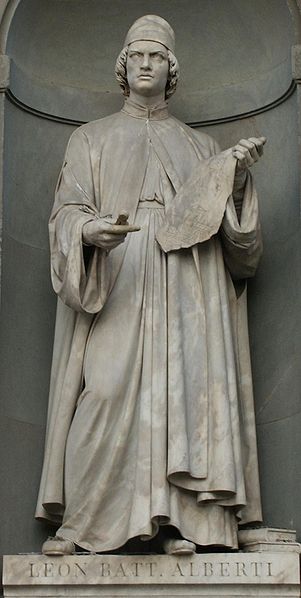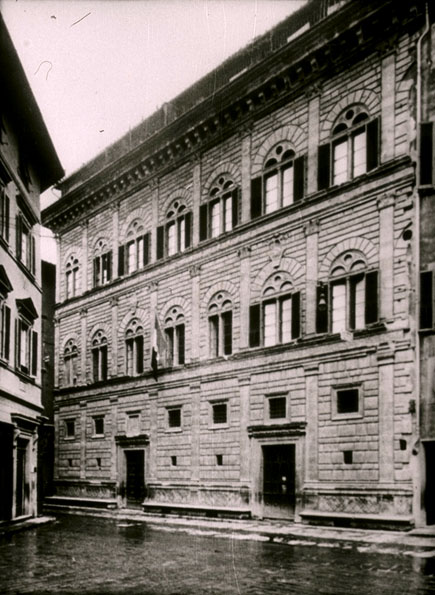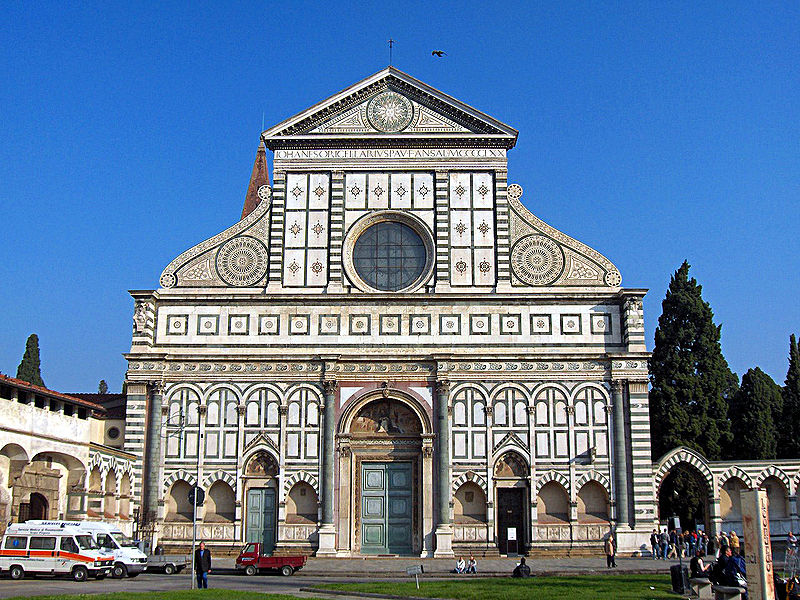<Back to Index>
- Physicist and Philosopher Ernst Mach, 1838
- Architect and Polymath Leon Battista Alberti, 1404
- Chairman of the Presidium of the Supreme Soviet Nikolai Viktorovich Podgorny, 1903
PAGE SPONSOR

Leon Battista Alberti (February 18, 1404 – April 20, 1472) was an Italian author, artist, architect, poet, priest, linguist, philosopher, and cryptographer, and general Renaissance humanist polymath. Alberti's life was described in Giorgio Vasari's Vite de' più eccellenti pittori, scultori, e architettori or 'Lives of the most excellent painters, sculptors and architects'.
An Italian humanist, Alberti is often seen as a model of the Renaissance "universal man." He was born in Genoa, one of two illegitimate sons of a wealthy Florentine merchant, Lorenzo Alberti. Leon Battista's mother, Bianca Fieschi, was a Bolognese widow who died during an outbreak of bubonic plague. Like many other families, the Albertis had been expelled from their native city, Florence, by the republican government, run by the Albizzis. At the time of Leon Battista's birth, his father Lorenzo lived in Genoa, but the family soon moved to Venice, where Lorenzo ran the family bank with his brother. Lorenzo married again in 1408. The ban on the family was lifted in 1428, and that same year Leon visited Florence for the first time.
Alberti received the best education then available to an Italian nobleman. From around 1414 to 1418 he studied classics at the famous school of Gasparino Barzizza in Padua. He then completed his education at the University of Bologna, where he studied law. In his youth, according to stories, Alberti could — with his feet together — jump over a man's head, he was a superb horseman, and he "learned music without a master, and yet his compositions were admired by professional judges."
After the death of his father, Alberti was supported by his uncles. In his twenties Alberti wrote On the Advantages and Disadvantages of Letters, which he dedicated to his brother Carlo, also a scholar and writer. Alberti's Latin comedy, Philodoxus, aimed
to teach that "a man dedicated to study and hard work can attain glory,
just as well as a rich and fortunate man." For a short time it was
passed as a genuinely antique Roman play. Like Petrarch, who had been the first famous philologist to
study the works of the ancient Roman poets, Alberti loved classics, but
he compared continual reading and rereading in libraries. Later he also
complained, that "the learned don't become rich, or if they do become
rich from literary pursuits, the sources of their wealth are shameful."
Other early works, Amator (ca. 1429), Ecatonfilea (ca. 1429), and Deiphira (ca. 1429 - 1434), dealt with love, virtues, and failed relationships. Alberti
received his doctorate in canon law in 1428. In the early 1430s he went
to Rome where he worked as an abbreviator at the Papal Curia,
drafting papal briefs. A master of Latin and Italian, Alberti also
rewrote in Latin traditional lives of saints and martyrs. After taking
holy orders to the priesthood, he was deemed to hold the priorate of
San Martino a Gangalandi at Lastra a Signa. In 1448 he was appointed
rector of the parish of San Lorenzo in Mugello. Alberti served also as
a papal inspector of monuments, and advised Pope Nicholas V, a former fellow student from Bologna, on the ambitious building projects in the city of Rome. In the mid 1430s, Alberti moved to Florence with Pope Eugenius IV, who had been driven out of the Holy City. Alberti was appointed canon of the Florentine Cathedral. He admired greatly its dome, designed by Filippo Brunelleschi.
At that time it was the largest in the world other than the Roman
Pantheon, a unique manifestation of the integration of art, science,
and technology, the spiritual symbol of the Florentine Rinascita. "Who
could be hard or envious enough to fail to praise Pippo [Filippo],"
wrote Alberti, "the architect on seeing here such a large structure,
rising above the skies, ample to cover with its shadow all the Tuscan
people." In 1450, Alberti was commissioned to transform the Gothic church of S. Francesco, Rimini, into a memorial to the local warlord Sigismondo Pandolfo Malatesta, his wife Isotta, and courtiers. The church is usually known as the Tempio Malatestiano.
Its dominating form is the classical triumphal arch, Alberti's favorite
structure, but the severe, restrained façade was never quite
finished. Alberti himself did not live in Rimini. He corresponded with
his assistants, who were responsible for most of the actual rebuilding.
Like the Tempio Malatestiano, the façade of Santa Maria Novella in
Florence is considered to be a landmark in the formation of Renaissance
architecture. The only buildings Alberti designed entirely himself, were S. Sebastiano (1460),
still under work during Alberti's lifetime, and S. Andrea, Mantua
(1470), completed in the 18th century. Its triumphal arch was even
grander than in the Tempio Malatestiano. De pictura (1435), the first version of On Painting, Alberti wrote in Latin. He then translated it into Italian under the title Della pittura (1436). Alberti dedicated the book to Filippo Brunelleschi, among others. He also credited Donatello (ca. 1386 - 1466), Lorenzo Ghiberti, Masaccio,
and Filippo with "a genius for every laudable enterprise in no way
inferior to any of the ancients." Brunelleschi was a self-learned
architect — originally he was trained as a goldsmith. Brunelleschi's
early achievements included his formulation of the laws of linear
perspective, which he presented in two panels. The creation of a
pictorial space and perspective was fundamental to Renaissance art. In
his own work, Alberti codified the basic geometry so that the linear
perspective became mathematically coherent and related to the
spectator. However, the technical first part of the book did not have
any illustrations. After Alberti, Piero della Francesca presented his own theory of perspective in De prospectiva pingendi. Alberti
regarded mathematics as the common ground of art and the sciences. "To
make clear my exposition in writing this brief commentary on painting," Alberti began his treatise, Della pittura (On Painting), "I will take first from the mathematicians those things with which my subject is concerned." This treatise (Della pittura ) was also known in Latin as De Pictura, and it relied in its scientific content on classical optics in determining perspective as
a geometric instrument of artistic and architectural representation.
Alberti was well-versed in the sciences of his age. His knowledge of optics was connected to the handed-down long standing tradition of the Kitab al-manazir (The Optics; De aspectibus) of the Arab polymath Alhazen (Ibn al-Haytham, d. ca. 1041), which was mediated by Franciscan optical workshops of the 13th century Perspectivae traditions of scholars such as Roger Bacon, John Peckham and Witelo (similar influences are also traceable in the third commentary of Lorenzo Ghiberti, Commentario terzo). In both Della pittura and De statua, a short treatise on sculpture, Alberti stressed that "all steps of learning should be sought from nature." The
ultimate aim of an artist is to imitate nature. Painters and sculptors
strive "through by different skills, at the same goal, namely that as
nearly as possible the work they have undertaken shall appear to the
observer to be similar to the real objects of nature." However, Alberti did not mean that artists should imitate nature objectively, as
it is, but the artist should be especially attentive to beauty, "for in
painting beauty is as pleasing as it is necessary." The
work of art is, according to Alberti, so constructed that it is
impossible to take anything away from it or add anything to it, without
impairing the beauty of the whole. Beauty was for Alberti "the harmony
of all parts in relation to one another," and subsequently "this
concord is realized in a particular number, proportion, and arrangement
demanded by harmony." Alberti's thoughts on harmony were not new — they
could be traced back to Pythagoras — but he set them in a fresh
context,
which fit in well with the contemporary aesthetic discourse. In Rome, Alberti had plenty of time to study its ancient sites, ruins, and objects. His detailed observations, included in his De Re Aedificatoria (1452, Ten Books of Architecture), were patterned after the De architectura by the Roman architect and engineer Vitruvius (fl. 46 - 30
B.C.). The work was the first architectural treatise of the
Renaissance. It covered a wide range of subjects, from history to town planning, and engineering to the philosophy of beauty. De re aedificatoria, a large and expensive book, was not fully published until 1485, after which it became a major reference for architects. However, the book was written "not only for craftsmen but also for anyone interested in the noble arts," as Alberti put it. Originally published in Latin, the first Italian edition came out in 1546 and the standard Italian edition by Cosimo Bartoli was published in 1550. Pope Nicholas V,
to whom Alberti dedicated the whole work, dreamed of rebuilding the
city of Rome, but he managed to realize only a fragment of his
visionary plans. Through his book, Alberti opened up his theories and
ideals of the Florentine Renaissance to architects, scholars and others. Alberti wrote I Libri della famiglia — which
discussed education, marriage, household management, and money — in the
Tuscan dialect. The work was not printed until 1843. Like Erasmus decades
later, Alberti stressed the need for a reform in education. He noted
that "the care of very young children is women's work, for nurses or
the mother," and that at the earliest possible age children should be
taught the alphabet. With
great hopes, he gave the work to his family to read, but in his
autobiography Alberti confesses that "he could hardly avoid feeling
rage, moreover, when he saw some of his relatives openly ridiculing
both the whole work and the author's futile enterprise along it." Momus, written between 1443 and 1450, was a misogynist comedy about the Olympian gods. It has been considered as a roman à clef — Jupiter has been identified in some sources as Pope Eugenius IV and Pope Nicholas V. Alberti borrowed many of its characters from Lucian,
one of his favorite Greek writers. The name of its hero, Momus, refers
to the Greek word for blame or criticism. After being expelled from
heaven, Momus, the god of mockery, is eventually castrated. Jupiter and
the other gods come down to earth also, but they return to heaven after
Jupiter breaks his nose in a great storm. For the Rucellai family in Florence Alberti designed several buildings, the façade of Palazzo Rucellai, executed by Bernardo Rosselino, the façade of Santa Maria Novella, the marble-clad shrine of the Holy Sepulchre, and perhaps also the Capella Rucellai. Among Alberti's smaller studies, pioneering in their field, were a treatise in cryptography, De componendis cifris, and the first Italian grammar. With the Florentine cosmographer Paolo Toscanelli he collaborated in astronomy, a close science to geography at that time, and produced a small Latin work on geography, Descriptio urbis Romae (The Panorama of the City of Rome). Just a few years before his death, Alberti completed De iciarchia (On Ruling the Household), a dialogue about Florence during the Medici rule. Alberti died on April 25, 1472 in Rome. As an artist, Alberti distinguished himself from the ordinary craftsman, educated in workshops. He was a humanist,
and part of the rapidly expanding entourage of intellectuals and
artisans supported by the courts of the princes and lords of the time.
Alberti, as a member of noble family and as part of the Roman curia, had special status. He was a welcomed guest at the Este court in Ferrara, and in Urbino he spent part of the hot-weather season with the soldier prince Federico III da Montefeltro. The Duke of Urbino was a shrewd military commander, who generously spent money on the patronage of art. Alberti planned to dedicate his treatise on architecture to his friend. Giorgio Vasari, who argued that historical progress in art reached its peak in Michelangelo,
emphasized Alberti's scholarly achievements, not his artistic talents:
"He spent his time finding out about the world and studying the
proportions of antiquities; but above all, following his natural
genius, he concentrated on writing rather than on applied work." (from Lives of the Artists). Leonardo, who ironically called himself "an uneducated person" (omo senza lettere),
followed Alberti in the view that painting is science. However, as a
scientist Leonardo was more empirical than Alberti, who was a theorist
and did not have similar interest in practice. Alberti believed in
ideal beauty, but Leonardo filled his notebooks with observations on
human proportions, page after page, ending with the famous drawing on the Vitruvian man, a human figure related to a square and a circle. "We painters," said Alberti in On Painting,
but as a painter, or sculptor, Alberti was a dilettante. "In painting
Alberti achieved nothing of any great importance or beauty," wrote
Vasari. "The
very few paintings of his that are extant are far from perfect, but
this is not surprising since he devoted himself more to his studies
than to draughtsmanship." Jacob Burckhardt portrayed Alberti in The Civilization of the Renaissance in Italy as
a truly universal genius. "And Leonardo da Vinci was to Alberti as the
finisher to the beginner, as the master to the dilettante. Would only
that Vasari's work were here supplemented by a description like that of
Alberti! The colossal outlines of Leonardo's nature can never be more
than dimly and distantly conceived." Burckhardt also mentions Alberti's love for animals. He had a pet dog, a mongrel, for whom he wrote a panegyric, Canis). Alberti is said to be in Mantegna's great frescoes in the Camera degli Sposi, the older man dressed in dark red clothes, who whispers in the ear of Ludovico Gonzaga, the ruler of Mantua. In
Alberti's self-portrait, a large plaquette, he is clothed as a Roman.
To the left of his profile is a winged eye. On the reverse side is the
question, Quid tum? (what then), taken from Virgil's Eclogues: "So what, if Amyntas is dark? (quid tum si fuscus Amyntas?) Violets are black, and hyacinths are black."

